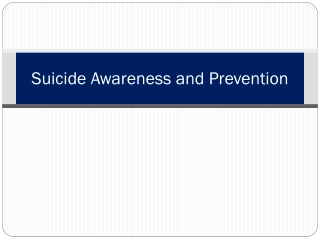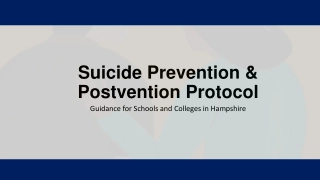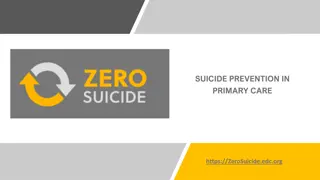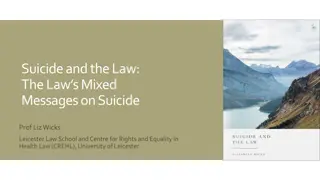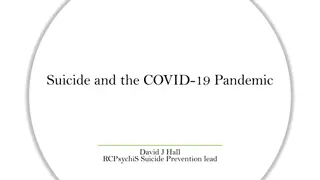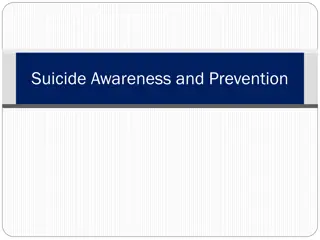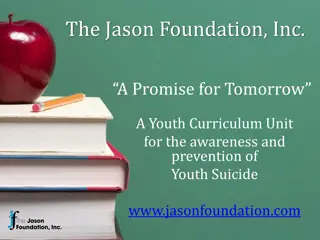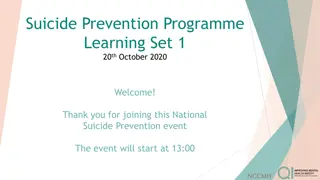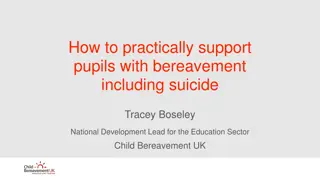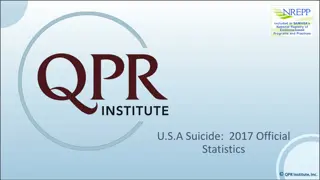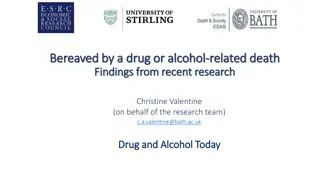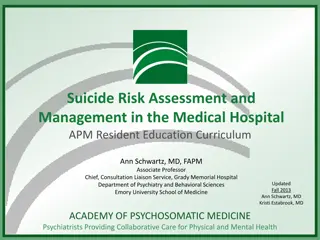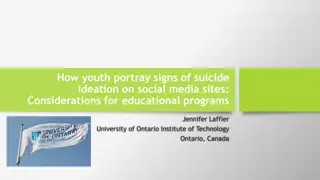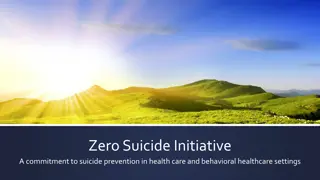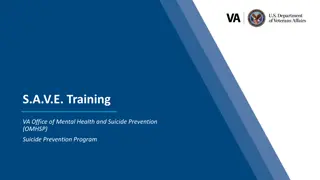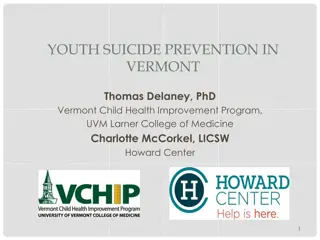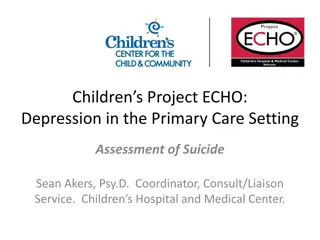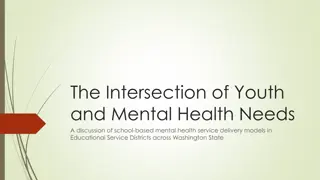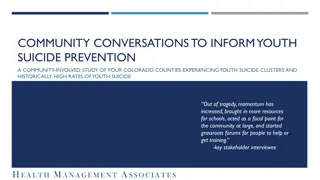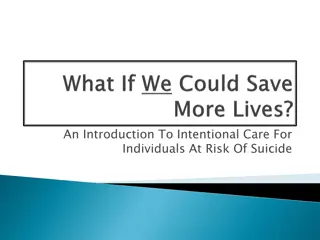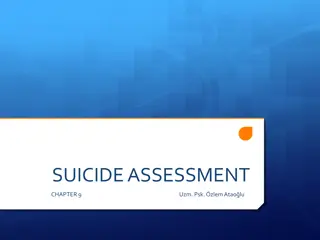Models of Care for Supporting Those Bereaved by Suicide
People bereaved by suicide are at higher risk of suicide themselves. Current support in the UK is lacking, with only 30% receiving formal assistance. Proposed proactive models of care, such as the Amparo model, are being implemented in selected UK areas to provide better support to families affected by suicide. The process involves police referral, allocation to a Suicide Liaison Worker, risk assessment, support planning, and follow-up. The results so far have shown positive impact on beneficiaries in Cheshire & Merseyside.
Download Presentation

Please find below an Image/Link to download the presentation.
The content on the website is provided AS IS for your information and personal use only. It may not be sold, licensed, or shared on other websites without obtaining consent from the author.If you encounter any issues during the download, it is possible that the publisher has removed the file from their server.
You are allowed to download the files provided on this website for personal or commercial use, subject to the condition that they are used lawfully. All files are the property of their respective owners.
The content on the website is provided AS IS for your information and personal use only. It may not be sold, licensed, or shared on other websites without obtaining consent from the author.
E N D
Presentation Transcript
Action 4 Support for those bereaved by suicide Models of Care Ruth Moss
ACTION 4 BACKGROUND People bereaved by the sudden death of a close friend or family member are 65% more likely to attempt suicide if the deceased died by suicide than if they died by natural causes (Pitman et al. 2014). This equates to a 1 in 10 risk of a suicide attempt. A prior suicide attempt is the single most important risk factor for suicide in the general population (WHO 2014). Cost of each suicide is around 1.67m, with 70% of that figure representing the emotional impact on relatives (Platt et al. 2006) Negative health and social outcomes.
CURRENT SUPPORT Research Study map what is available No Scottish data but 70% of British people bereaved by suicide receive no formal support (McKinnon and Chonody 2014). Geographical provision is variable No centrally commissioned, formal model of care Voluntary sector led
PROPOSED MODEL PROACTIVE MODEL OF CARE TO SUPPORT FAMILIES Examined different models nationally and internationally N. Ireland, USA, Australia Amparo model 2015 Cheshire and Merseyside, 2019 Suffolk, Norfolk, Lancashire (selected areas with high suicide rates) and South Yorkshire (selected areas with high suicide rates) 7.7 million people in England covered by this service
Sudden / Suspicious death: police attend the scene Police can consent and refer directly to the service. Where support is declined initially, other mechanisms of accessing the service e.g. GP, self-referral, NHS, SW. Support until end of review process More evaluation other than WEMWEBS More signposting other than SOBS dependent upon needs of beneficiary. Other key features of the service Police meet with Next of Kin or other significant family member / found by Process Map Police report suspected suicide into Coroner s Office 3rd party professional recommends AMPARO Coroner s Officer (CO) allocated to case recommends AMPARO support AMPARO support confirmed: CO fills out referral form and sends via secure email AMPARO support declined: no further action Referral received by Referral Team and allocated to a suitable Suicide Liaison Worker (SLW) - no waiting list as processed on receipt; notes logged in communication record for access by SLW SLW commences contact process with referral within 24hrs of referral Contact unsuccessful: letter sent out, wait 7 days; if no contact, case is closed; if contact established Contact successful: support declined: no further action Contact successful: support established 1-1: visit offered within 7 days Phone only support: full risk assessment conducted; support plan put in place 1-1 visit: risk assessment carried out; support plan put in place; follow-up calls organised Initial WEMWEBS completed Risk assessment logged and filed on Lamplight Signpost to SOBS Support at Inquest Final WEMWEBS completed AMPARO: PM 17/10/2018
RESULTS Within 2 years - 265 direct beneficiaries and a further 975 Cheshire & Merseyside residents who had been exposed to suicide. In Cheshire & Merseyside estimated that 9% of those who died by suicide in 2014 had been bereaved by suicide themselves (coroners audit). Following the commencement of the Amparo suicide liaison service this fell to 6% in 2015 and between 2015 and 2019, a coroner s audit shows that no beneficiaries of the service have taken their lives since then. Since expansion, AMPARO has engaged with over 3,500 individuals (either direct referrals, indirect referrals, people provided with initial brief advice and people that engaged with a community response plan)
RESULTS cont. Annual average uptake of the service is 70.5% of referrals to beneficiaries Since 2014, zero Amparo beneficiaries have gone on to take own life Service expanded. It is now running in Cheshire and Merseyside, Suffolk, Norfolk, Lancashire (selected areas with high suicide rates) and South Yorkshire (selected areas with high suicide rates)
LIVES SAVED ISD/NRS do not collate data on suicides relating to those bereaved by suicide themselves. This makes it a difficult area to evaluate in terms of numbers or the success of any potential interventions. Research lacking. If we assume that 9% is an average figure in terms of those bereaved by suicide themselves taking their own life (big assumption but based on English model), then in Scotland that would translate to the saving of 71 lives per year
PROJECTED COSTS (Estimate only at this stage) Example of 2 potential areas ..
PROGRESS ACHIEVED Commissioning of research, Individual research, evaluation methods - research Current stakeholder engagement: Amparo (currently running the model in England) Police Scotland (Police Scotland have agreed to allocate a FLO to every family bereaved by suicide. Previously, FLOs were only allocated in the case of homicides.) Winston s Wish SAMH MHF Touched by Suicide CHAS Business in the Community Lothian Rivers Trauma Centre - Lead psychologists and Service Leads COPFS Deputy Head of Scottish Fatalities Investigation Unit, Deputy Crown Agent Serious Casework Various lecturers Stirling University
NEXT STEPS Engagement with the AAG, lived experience panel and policy team Further stakeholder engagement e.g. RCGP, Victim Support, NHS, COSLA, current providers. Develop accurate financial estimates Bring a proposal to NSPLG and SG to pilot the model (Police Scotland are already engaged) Gain agreement from NSPLG group and SG for a pilot Develop an implementation plan including: Marketing, communications and partnerships Stakeholder engagement Workforce Development Information Sharing Pathways I.T. Information Governance Performance and Quality Standards Service Monitoring Evaluation methods In conjunction with this, work is required to look at the wider picture in terms of suicide clusters and groups
REFERENCES Andriessen, K. et al., 2019. Effectiveness of interventions for people bereaved through suicide: a systematic review of controlled studies of grief, psychosocial and suicide-related outcomes. BMC Psychiatry, Vol.19(1), pp. 1-15. Cerel, J. et al. 2014. The continuum of survivorship: Definitional issues in the aftermath of suicide. Suicide and Life Threatening Behavior, 561, pp. 591-600. CHAMPS Public Health Initiative. 2018. Strategic Plan 2018-2020 https://moderngov.cheshireeast.gov.uk/documents/s68240/App%20A%20-%20Strategic%20Delivery%20Plan.pdf (Accessed 11/07/2019) Constantino, R. E. et al., 2001. Group intervention for widowed survivors of suicide. Suicide and life threatening behaviour, 31(4), pp.428-41 Dyregrov, K., 2011. What Do We Know About Needs for Help After Suicide in Different Parts of the World? Crisis. 32(6), pp. 310-8 Foggin, E. et al. 2016. GPs Experiences of Dealing with Parents Bereaved by Suicide: A Qualitative Study. British Journal of General Practice66 (651), pp. 737-746 http://bjgp.org/content/66/651/e737. (Accessed 15/07/2019) Griffin, E. and McMahon, E., 2019. Suicide Bereavement Support: a Literature Review. National Suicide Research Foundation, Ireland. https://www.nsrf.ie/wp-content/uploads/2019/05/suicide-bereavement-support-a-literature-review-april-2019.pdf (Accessed 11/07/19) McKinnon, J. M., and Chonody, J. 2014. Exploring the formal supports used by people bereaved through suicide: a qualitative study. Social Work in Mental Health, 12(3), pp. 231- 248 NICE 2018, Preventing suicide in community and custodial settings: Postvention [Evidence review for interventions to support people bereaved by suicides]. https://www.nice.org.uk/guidance/ng105/documents/evidence-review-5. (Accessed 12/02/2019) Pfeffer, C.R. et al., 2002. Group intervention for children bereaved by the suicide of a relative. Journal of the American Academy of Child and Adolescent Psychiatry, 41 (5), pp. 505-513. Pitman, A. et al., 2014. Effects of suicide bereavement on mental health and suicide risk. Lancet Psychiatry, 1(1), pp. 86-94 Pitman, A. et al., 2016. The stigma perceived by people bereaved by suicide and other sudden deaths: A cross-sectional UK study of 3432 bereaved adults. Journal of Psychosomatic Research 87, pp. 22-29
REFERENCES cont.. Pitman, A. et al., 2018. Support Needs and Experiences of People Bereaved by Suicide: Qualitative Findings from a Cross-Sectional British Study of Bereaved Young Adults International Journal of Environmental Research and Public Health, 15 (4), e.666. Platt, S. et al., 2006. Evaluation of the first phase of Choose Life: the national strategy and action plan to prevent suicide in Scotland. Edinburgh: Scottish Executive Social Research Public Health England, 2016. Support after a suicide: A guide to providing local services - A practical resource. https://assets.publishing.service.gov.uk/government/uploads/system/uploads/attachment_data/file/590838/support_after_a_suici de.pdf (Accessed 11/07/2019) Support After Suicide Partnership 2019. Local Services. https://supportaftersuicide.org.uk/local-services/ (Accessed 11/07/2019) Visser, V. S. et al., 2014, Evaluation of the effectiveness of a community-based crisis intervention program for people bereaved by suicide. Journal of Community Psychology, 42(1), pp. 19-28 World Health Organisation, 2014. Preventing Suicide a global iniatiative https://apps.who.int/iris/bitstream/handle/10665/131056/9789241564779_eng.pdf;jsessionid=FC9BB83BBA2238B489B2558C95B 6E095?sequence=1




